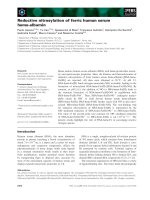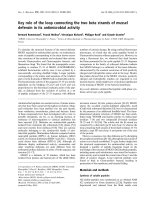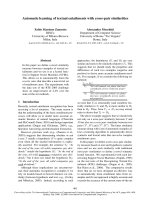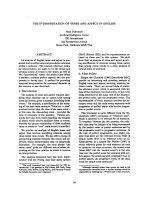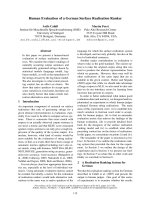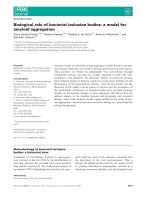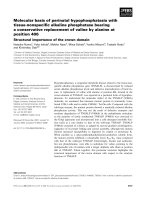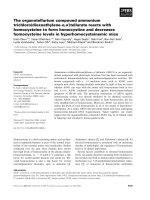báo cáo khoa học: "The role of 18F-FDG-PET/CT in the preoperative staging and posttherapy follow up of gastriccancer:Comparison with spiral CT" docx
Bạn đang xem bản rút gọn của tài liệu. Xem và tải ngay bản đầy đủ của tài liệu tại đây (192.89 KB, 5 trang )
RESEARC H Open Access
The role of 18F-FDG-PET/CT in the preoperative
staging and posttherapy follow up of
gastriccancer: Comparison with spiral CT
Elgin Ozkan, Mine Araz
*
, Cigdem Soydal and Ozlem N Kucuk
Abstract
Background: The aim of this study was to investigate the role of F-18 fluoro-deoxy-glucose (FDG) positron
emission tomography and computed tomography (PET/CT) in the preoperative and posttherapy restaging of
gastric cancer and to compare with spiral computerized tomography (CT).
Method: A total of 42 PET/CT scans of 36 gastric cancer patients (28M, 8F; mean age: 56,0 ± 15) were included in
the study. A retrospect ive analysis of the PET/CT results of the patients were compared with concurrent CT results.
Confirmation was made by clinical course and serial imaging studies in the follow up. The compatibility ratios were
calculated and the accuracy of the PET/CT was assessed. Agreement between PET/CT and concurrent CT was
calculated using kappa statistics.
Results: Patients were separated into 3 groups: the patients who were referred to our clinic for preoperative
staging (4 patients), for posttherapy evaluation (24 patients) and for the suspicion of local recurrence and/or
metastasis exploration after a disease free period (8 patients). Groups 1 and 3 included a small number of patients
so they were omitted from the statistical analysis. Focusing on Goup 2, the overall concordance rate was 50% (12
patients). Region based analysis sho wed the rates of concordance for local recu rrence, local lymph node metastasis
and distant metastasis were 91% (Kappa: 0.70), 95% (Kappa:0.86) and 50% (Kappa:0.26) respectively. Distant
metastases were also investigated in detail and the two techniques showed a concordance of 91% (Kappa: 0.75)
for liver, 79%(Kappa:0.31) for distant lymph node, 79% (0.42) for lung, 87%(Kappa:0.33) for bone and 95% for
intestinal wall metastasis.
Conclusion: PET/CT is a complementary imaging method which can be successfully used in both preoperative
and posttherapy evaluation of gastric cancer.
Keywords: Gastric cancer, FDG-PET/CT, spiral CT
Background
Gastric cancer is the fourth most frequent type of cancer
and 934.000 new cases arise eac h year worldwide [1].
Japan, China, East Europe and Latin America are reported
as areas of high incidence of gastric cancer. The survival
rates are generally very low because the patients usually
have a high stage disease at diagnosis [2].
The only curative therapy for gastric cancer is the
resection o f both the tumor and the regional lym ph
nodes at the early stage of the disease. The evaluation of
tumor resectability, local lymph node and regional solid
organ and distant metastasis in the preoperative stage
plays a crucial role in terms of planning a true surgery or
avoiding unnecessary surgical interventions in high stage
patients. Computed Tomography (CT) i s frequently used
for preoperative staging in gastric cancer patients. Endo-
scopic ultrasonography (USG) is known to be the most
reliable method in the preoperative T staging of the dis-
ease [3,4]. However, the high technology multislice CT
systems are reported to give results as accurate as endo-
scopic USG [5,6]. For nodal staging and evaluation of
distant metastasis, spiral CT is also currently the m ethod
of choice in the preoperative stage [7]
* Correspondence:
From the Department of Nuclear Medicine, Ankara University, Medical
Faculty, Ankara, Turkey
Ozkan et al. World Journal of Surgical Oncology 2011, 9:75
/>WORLD JOURNAL OF
SURGICAL ONCOLOGY
© 2011 Ozkan et al; licensee Bi oMed Central Ltd. This is an Open Acc ess article distributed under the terms of the Creative Commons
Attribution License ( ), which permits unrestrict ed use, distribution, and reproduction in
any medium, provided the original work is properly cited.
In gastric cancer patients, detecting the recurrences is
hard in the posttherapy follow up period. An elevation in
the tumor markers like carcinoembryonic antigen (CEA)
and Ca19-9 may help but there is still a need of a reliable
method for the localizati on of recurrence. CT is the pre-
ferred method for this aim. However it is reported that CT
has a limited value in the evaluation of the postoperat ive
changes [7]. To determine the therapy response, the volu-
metric changes on CT is similarly used in the routine pro-
cedure. But especially in the detecion of the response in
the primary tumor, these changes may not always be rea-
lized accurately [7]. When it comes to the detection of the
solid organ and especially distant metastasis, although CT
is currently used, there are some reports showing that as a
whole body imaging method, Positron Emission Tomogra-
phy (PET) is superior to anatomic imaging tools. But the
role of 18F-Fluorodeoxyglucose (FDG)-PET/CT in the
diagnosis of distant lymph node, bone or lung metastasis
is uncertain [8].
18F-FDG-PET is a functional imaging method detecting
the metabolically active tumor. It i s well known that the
primary energy source for cancer cells is glucose. Active
tumor cells have an uncontrolled growth and division and
therefore their metabolism mostly depend on anaerobic
respiration which requires a greater amount of glucose
consumption compared to the healthy tissues. FDG enters
into the cell and is phosphorylated by hexokinase activity
but can no longer be metabolized. Therefore it is trapped
in the cell. Highly active malignant cells concentrate more
FDG than normal tissues which provides the functional
imaging in cancer patients. Hybrid PET/CT systems pro-
vide fusion images combining functional and anatomic
imaging together [9].
The aim of this study was to investigate the role of F-18
fluoro-deoxy-glucose (FDG) positron emission tomogra-
phy and computed tomography (PET/CT) in the preo-
perative and p osttherapy restaging of gastric cancer and
to compare with conventional CT.
Method
Patient Group
In this retrospective analysis, we reviewed a total of 51
PET/CT reports of 44 primary gastric adenocarcinoma
patients to whom PET/CT was performed in the preo-
perative stage or for posttherapy restaging between
January 2007 and January 2010. We used the clinical
fol low up registery of our hospital in order to reach the
reports of t heir conventional imaging examinations and
other investigations. We couldn’t get the results of the
medical examinations of 8 of these patients (a total of 9
PET/CT scans) who were referred only for PET/CT
scan to our centre. They were omitted from the study.
As a result, 36 gastric cancer patients (28M, 8F; mean
age:56,0 ± 15) and 42 PET/CT reports were included in
the study. 5 patients have undergone at least 2 P ET/CT
scans. The concurrent thoracoabdominal CT results
were compared with the P ET/CT results. Also, some of
them had undergone additional imaging examinations
like USG, Magnetic resonance imaging (MRI) or bone
scintigraphy; so they were also taken under considera-
tion. Confirmation was made by clinical course and
serial imaging tests.
The subjects w ere divided into three groups. 4/42 of
the analysed scans were performed for preoperative sta-
ging (group 1), 30/42 of the for posttherapy restaging
(Group 2) and 8/42 for recurrence or metastasis search
because of tumor marker ele vation in the disea se free
follow up period (Group 3). Groups 1, 2 and 3 included
4, 24 and 8 patients respectively.
PET/CT and Spiral CT
All spiral thoracoabdominal CT examinations were per-
formed with oral and i.v. contrast agents. PET/CT imaging
was done using the GE Discovery ST- 8 slices scanner.
PET scans were performed after 6 hours of fasting. Blood
glucose levels were checked just before the procedure.
Average 296-370 MBq (8-10 mCi) FDG were injected
intravenously and images were obtained 1 hour later from
the orbitomeatal line to the mid thigh. Low dose CT
images were used for attenuation correction. Oral contrast
agent was given to all patients during PET/CT imaging. A
semiquantitative and visual analysis was made. Images
were evaluated by two nuclear medicine specia lists and a
consensus was reached in order to avoid interobserver
variability. A focal uptake with a SUV>2.5 was considered
pathological.
Statistical analysis
Because the number of patients included in Groups 1 and
3 were not meaningful enough to be analysed statistically,
statistics focused on the second group of 24 patients.
The results of PET/CT and conventional CT studies
were compared in terms of the recurrence in the pri-
mary gastric tumoral focus, abdominal lymph node
metastasis and distant metastasis.
Then the aggrement between two imaging techniques
were checked by calculation of Kappa statistics. The
analyses were performe d using the SPSS software, ver-
sion 11.5.0 (SPSS Inc.,Chicago,Illinois,USA).
Then the concordance and discordance between these
two imaging modalities were investigated by checking
the reliability. As most of the patients included were in
the restaging group, the gold Standard histopathological
confirmation could not be possible. So, sensitivity, speci-
ficity, positive and negat ive predictive values and accur-
accy could not be calculated.
Ozkan et al. World Journal of Surgical Oncology 2011, 9:75
/>Page 2 of 5
Results
In 16/36 (44%) patients, the results of the PET/CT and
CT studies showed completely concordant findings and
no additional foci were detected by PET/CT. Of these
16 patients, 2/16 were in the first group, 12/16 in
Group 2 and 2/16 in Group3.
In group 1, 2/4 patients (50%) had compatible PET/CT
and CT results. In the other half of these patients PET/
CT gave more accurate results than thoracoabdominal
CT examinations.
In1/2ofthesepatients,PET/CTshowedincreased
metabolism in the abdominal lymph nodes in addition to
the lesions also detected by CT. These foci were all con-
fir med histopathologicall y after surger y. In the other 1/2
patient, the millimetric lung nodules diagnosed by thorax
CT were non-FDG avid. Although the possibility of metas-
tasis cannot be totally eliminated in millimetric non-FDG
avid nodules, because no changes developed in either size
or characteristics of the nodule, lung metastasis was not
clinically considered in this patient.
Group 2 included 24 patients. The number of patients
who had compatible results of PET/CT and CT in group 2
(overall concordance) was 12/24 (%50). The accuracy of
the PET/CT results in the discordant group (12/24) were
confirmed clinically. 1/12 of them also had histopathologi-
cal confirmation. The two imaging methods showed con-
cordant findings in 22 patients (%91) for local recurrence
and in 23 patients (95%) for local lymph node metastasis.
The evaluation of distant metastasis showed a rate of 50%
overall concordance. The subgroup analysis of distant
metastases was also done. The regions of distant metasta-
sis noted were liver, distant lymph nodes, lungs, bones and
intestinal wall. The number of patients who ha d concor-
dant findings for defining liver metastasis was 22 (91%)
(Kappa:0.75), distant lymph node metastasis was 19 (79%)
(Kappa:0.31), lung metastasis was 18 (75%) (Kappa:0.42),
bone metastasis was 21 (87%) (Kappa:0.33) and intestinal
wall was 23 (95%). Becasue there was only one patient
who had intestinal wall involvement, Kappa could not be
calculated ( Table 1).
In Group 3 there were 8 patients referred upon detec-
tion of high tumor marker levels with a local recurrence
or distant metastasis suspicion. In 2/8 patients (25%), the
two imaging modalities showed completely the same
lesions. In 6/8 (75%) patients however, it was clinically
confirmed that the extra lesions shown by PET/CT were
positive. There were no lesions detected by CT but not
with PET/CT.
Discussion
The most reliable noninvasive tool routinely used for the
preopera tive TNM staging of gastric cancers is spiral CT.
But as an anatomic imaging method, CT is known to
have a low sensitivity and spesificity at N staging of the
disease [10]. Because it basically names the lymph nodes
pathological if there is an increase in the size and this
may fail if the change in size is due to inflammatory pro-
cess [11]. So PET/CT has evolved as a promisin g meta-
bolic imaging modality not only showing the morphology
but also the pathological metabolic activity of the
tumoral tissues. The studies comparing CT with PET
alone in the preoperative lymph node staging of gastric
cancer reported that PET is not superior to CT. This is
related with the low resolution of PET and p erigastric
lymph nodes cannot be distinguished easily from the pri-
mary tumor. But combined PET scans with CT provides
a precise localisation like it is in our study (95%) [12-14].
In 1/4 patients to whom PET/CT was performed in order
to make staging in the preoperative stage, FDG uptake
was observed in the gastric region and CT showed that
this activity was belonging to pathological regional lymph
nodes not reported as pathological on spiral CT. The
superiority of PET/CT, a metabolic imaging tool, over
CT in the preoperative N staging is marked in this case.
In the literature, although PET/CT does not have a
role in T staging in the preoperative state, sensitivity
and specificity of PET/CT in showing the primary
tumor is reported as %58-94 and %78-%100 respectively
[9]. In all patients in group 1, compatible to CT, the pri-
mary tumoral focus showed FDG uptake in our study. It
is an important limitation th at the number of patients is
small especially in the first group, the number of studies
intheliteratureinvestigatingtheroleofPETinthe
diagnosis of distant metastasis preoperatively is also very
small. In a series reported, sensitivity and spesificity of
PET in the diagnosis of liver metastasis was 85% and
74% respectively, 67% and 88% in lung metastasis [15].
In our study, in 1/4 of the Group 1 patients had lung
nodules on CT but these nodules didn’ tshowFDG
uptake and no pathological change in size or character-
ist ics developed, so they were clinical ly accepted as non
metastatic.
Table 1 The rates of concordance and discordance and
calculated Kappa values for PET/CT and spiral CT
CONCORDANCE DISCORDANCE KAPPA
LOCAL RECURRENCE 22 (91%) 2 (9%) 0.7
LOCAL LYMPH NODE
METASTASIS
23 (95%) 1 (5%) 0.86
DISTANT METASTASIS 12 (50%) 12 (50%) 0.26
LIVER 22 (91%) 2 (9%) 0.75
DISTANT LYMPH NODE
METASTASIS
19 (79%) 5 (21%) 0.31
LUNG 19 (79%) 5 (21%) 0.42
BONE 21 (87%) 3 (13%) 0.33
INTESTINAL WALL 23 (95%) 1 (5%) -
OVERALL 12 (50%) 12 (50%) -
Ozkan et al. World Journal of Surgical Oncology 2011, 9:75
/>Page 3 of 5
Group 2 included the 24/36 patients who have under-
gone PET/CT in the posttherapy follow up. A total of
30 PET/CT scans were performed to these patients.
When these scans were analysed on the lesion basis, th e
overall compatibility of CT and PET/CT scans was 50%.
The results were generally compatible for regional
recurrences (91%, Kappa:0.7) o r local lymph node
metastasis (95%, Kappa:0.86) but the incompatibility was
mainly due to distant metasta sis (5 0% Kapp a:0.26).
Enough information could not be provided in the litera-
ture about the role of PET/CT in this group of pati ents.
We think that our clinical experinces given in this
report will contribute the literature.
In 2/24 patients with incompatible results (9%) for the
evaluation of operated zone, local recurrence was clini-
cally confirmed despite a norma l spiral CT. In the litera-
ture no conventional imaging method is reported to have
sensitivity or s pecificity good enough for a reliable eva-
luation [16]. FDG PET also has a low sensitivity i n
detecting local lymph nodes. PET/CT hybrid systems
theoretically have a higher senstivity but further studies
with large patient groups are nee ded in order to reveal
thetruebestmodality.Whilethetwotechniqueswere
generally compatible in the detection of local lymph node
metastasis, in 1/24 (5%) patients, lo cal lymph nodes
showed pathological FDG uptake although they were not
apparent on CT.
When it comes to the distant metastasis, the results of
the analysis for liver metastasis showed that in 2/24 (9%)
patients there was a strong suspicion that the liver metas-
tasis still existed after chemotherapy as dynamic MRI or
hepatobiliary studies have suggested. However no FDG
uptake was seen in these areas. In t he clinical follow up,
itwasprovedthatthissituationwasrelatedwiththe
early metabolic response to therapy before anatomic
response became evident. As demo strated in these cases,
we concluded that PET/CT has an important role in
determining the early metabolic response to therapy
before anatomic response develops or that chronic non
specific changes not certainly distinguishable from malig-
nity can be clarified by PET/CT.
Although mostly compatible findings with CT were
obtained, PET/CT showed additionally extra uptake in
distant lymph nodes in 5 patients (21%). In these high
stage patients who have un dergone surgery and multiple
combined chemo-radiotherapies, restaging with lymph
node sampling was not clinically appropriate. Because
the minimum SUVmax value measured in these addi-
tional lymph nodes was 4.1, they were clinica lly accepted
metastatic. A cut-off SUVmax value for lymph nodes to
accept as malignant in gastric cancer patients has not
been reported yet. Kim and colleagues accepted the cut
off SUVmax value as 2.5 in their study at which the role
of PET/CT was investigated, and they found out the
sensitivity of the technique 40% [12]. In our study,
because there was no histopathological confirmation,
statistical analysis was not possible, but because the SUV-
max values we reported were much higher than their
cases, the sens itivi ty of PET/CT in our study is probably
higher.
In 5/24 of the patients (21%) in group 2, no FDG
uptake was seen in the milimetric lung nodules detected
by CT. No clinically evident metastasis was seen in the
clinical follow up or increase in siz e was detected in the
following control CT examinations.
In the evaluation of the skeletal metastasis, the rate of
discordance was 13% (3/24 patients) although CT
showed no bone lesions in 1/24 patients, PET/CT
showed the diffuse bone metastasis throughout the body
which was proved by bone sc intigraphy and the patient
was already clinically symptomatic. In 2/24 of the
patients however, PET/CT failed to show the sclerotic
lesions reported on spiral CT.
In 1/24 patient, the abdominal CT was normal but
pathological uptake was seen in the intestinal wall at the
splenic flexura and the rectum on PET/CT (SUVmax:8,3
and 14,0). The colonoscopic biopsy results confirmed
that these foci were related to gastric adenocancer
metastasis.
In 2/8 patients in group 3, compatible results were
found. In these 2 patients because both PET/CT and
diagnostic CT scans were reported as normal, patients
were taken under routine follow up. In the other 5/7
patients, PET/CT has additionally showed multiple
abdominal lymph nodes in 1 patient, local recur rence
and multiple bone metastases in 1 patient. In 1/5 patient
while a single f ocus of liver metastasis was reported on
CT, PET/CT revealed multiple metastasis in the liver
with SUVmax:8.9. In this case PET/CT was helpful in
detecting the new metastatic foci which are metaboli-
cally active but not radiologically visible yet. This patient
was taken under a chemotherapy programme again.
Lesions in the lung in 1 patient and in the proximal
jejunal segments of the intestine in another patient were
not FDG avid. So they were accepted as non malignant
and no therapy indication was discussed clinically.
As per the National Comprehensive Cancer Network
(NCCN) guidelines published, the role of FDG PET in
the preoperative staging of gastric cancer is said to be
stilluncertainbutitismostusefulindetecting
advanced disease [14]. Our results corroborate this
guideline. We found that PET/CT is complementary to
conventional CT in detectin g distant metastasis at high
stage disease. In the preoperative period, PET is not yet
accepted because it cannot give the exact T stage and N
stage of the disease, but in our study hybrid PET/CT
was confirmed to be as successful as spiral CT in N sta-
ging, although T staging was of course not possible. So
Ozkan et al. World Journal of Surgical Oncology 2011, 9:75
/>Page 4 of 5
hybrid PET/CT systems may much probably be superior
to PET alone as they can provide extra information of
precise localization. A recent study by Hur et al. also
showed that PET/CT is helpful in both N and M staging
and therefore aids in the patient selection for surgery or
avoiding unnucessary laparotomy [17]. The guideline
also recommends PET for evaluation of therapy
response and to make the decision of continuing the
ongoing therapy or stopping and redirecting the patient
to other salvage therapies. Our study also supports the
idea of routine use of PET or preferably PET/CT in the
posttherapy follow up.
As a result, when statistical results are reviewed, it is
recognized that high Kappa values (>0.7) for local recur-
rence a nd local ly mph node metastasis were calculated and
that this concordance showed PET/CT had a similar diag-
nostic power to spiral CT. However the low Kappa levels
calculated for distant metastasis revealed that there was a
significant discordance between two techniques. This s itua -
tion was mainly due to the sclerotic bone lesions and milli-
metric lung nodules that PET/CT had failed to show. The
clinical significance of this situation is uncertain as the
millimetric nodules were proved to be non-malignant in
the clinical course. When it comes to skeletal metastases,
not sclerotic but lytic lesions can be apparently diagnosed
by PET/CT. The mechanism of low FDG uptake in sclero-
tic lesions have been hypothesized before. FDG scanning
depends on the metabolic activity of the tumor. Because
sclerotic lesions include a smaller amount of metabolically
active cell s, they have a lower FDG uptake cannot be easily
shown by FDG PET. But lytic metastases can be detected
successfully [18]. So the clinical experience we get from
this study is that the complementary role of FDG PET/CT
in the clinical follow up of gastric cancer patients cannot
be ignored, keeping in mind its ability to provide a whole
body imaging and much less radiation exposure compared
to spiral CT.
Conclusion
Accordi ng to t he results of this study, we conclude that
PET/CT is a complementary imaging method which can
be successf ully used in both preoperative and postther-
apy evaluation of gastric cancer.
Authors’ contributions
EO participated in the design of the study and drafted the manuscript. MA
and CS performed the statistical analysis, documentation of the data,
literature analysis and participated in drafting the manuscript. OK conceived
of the study, and participated in its design and coordination. All authors
read and approved the final manuscript.
Competing interests
The authors declare that they have no competing interests.
Received: 16 February 2011 Accepted: 14 July 2011
Published: 14 July 2011
References
1. Parkin DM, Bray F, Ferlay J, Pisani P: Global cancer statistics, 2002. CA
Cancer J Clin 2005, 55(2):74-108.
2. Chandanos E, Lagergren J: Oestrogen and the enigmatic male
predominance of gastric cancer. Eur J Cancer 2008, 44(16):2397-403.
3. Kelly S, Harris KM, Berry E, Hutton J, Roderick P, Cullingworth J,
Gathercole L, Smith MA: A systematic review of the staging performance
of endoscopic ultrasound in gastro-oesophageal carcinoma. Gut 2001,
49(4):534-539.
4. Willis S, Truong S, Gribnitz S, Fass J, Schumpelick V: Endoscopic
ultrasonography in the preoperative staging of gastric cancer: accuracy
and impact on surgical therapy. Surg Endosc 2000, 14(10):951-954.
5. Bhandari S, Shim CS, Kim JH, Jung IS, Cho JY, Lee JS, Lee MS, Kim BS:
Usefulness of three-dimensional, multidetector row CT (virtual
gastroscopy and multiplanar reconstruction) in the evaluation of gastric
cancer: a comparison with conventional endoscopy, EUS, and
histopathology. Gastrointest Endosc 2004, 59(6):619-626.
6. Habermann CR, Weiss F, Riecken R, Honarpisheh H, Bohnacker S,
Staedtler C, Dieckmann C, Schoder V, Adam G: Preoperative staging of
gastric adenocarcinoma: comparison of helical CT and endoscopic US.
Radiology 2004, 230(2):465-471.
7. Kim KW, Choi BI, Han JK, Kim TK, Kim AY, Lee HJ, Kim YH, Choi JI, Do KH,
Kim HC, Lee MW: Postoperative anatomic and pathologic findings at CT
following gastrectomy. Radiographics 2002, 22(2):323-336.
8. Kinkel K, Lu Y, Both M, Warren RS, Thoeni RF: Detection of hepatic
metastases from cancers of the gastrointestinal tract by using
noninvasive imaging methods (US, CT, MR imaging, PET): a meta-
analysis. Radiology 2002, 224(3):748-756.
9. Lynch TB: Introduction. PET/CT in Clinical Practice Springer-Verlag London;
2007, 1-15.
10. Dassen AE, Lips DJ, Hoekstra CJ, Pruijt JF, Bosscha K: FDG-PET has no
definite role in preoperative imaging in gastric cancer. Eur J Surg Oncol
2009, 35(5):449-55.
11. Lim JS, Yun MJ, Kim MJ, Hyung WJ, Park MS, Choi JY, Kim TS, Lee JD,
Noh SH, Kim KW: CT and PET in stomach cancer: preoperative staging
and monitoring of response to therapy. Radiographics 2006, 26(1):143-56.
12. Kim SK, Kang W, Lee JS Kim HK, Kim HK, Chang HJ, Choi JY, Lee JH,
Ryu KW, Kim YW, Bae JM: Assesment of Lymph node metastasis using
18F-FDG PET in patients with advanced gastric cancer. Eur J Nucl Med
Mol Imaging 2006, 33(2):148-155.
13. Yun M, Lim JS, Noh SH, Hyung WJ, Cheong JH, Bong JK, Cho A, Lee JD:
Lymph Node Staging of Gastric Cancer Using18F-FDG PET: A
Comparison Study with CT. J Nucl Med 2005, 46(10):1582-1588.
14. Podoloff DA, Advani RH, Allred C, Benson AB, Brown E, Burstein HJ,
Carlson RW, Coleman RE, Czuczman MS, Delbeke D, Edge SB, Ettinger DS,
Grannis FW Jr, Hillner BE, Hoffman JM, Kiel K, Komaki R, Larson SM,
Mankoff DA, Rosenzweig KE, Skibber JM, Yahalom J, Yu JM, Zelenetz AD:
NCCN Task Force Report: Positron Emission Tomography (PET)/
Computed Tomography(CT) Scanning in Cancer. J Natl Compr Canc Netw
2007, 5(Suppl 1):S1-S22, quiz S23-2.
15. Yoshioka T, Yamaguchi K, Kubota K, Saginoya T, Yamazaki T, Ido T,
Yamaura G, Takahashi H, Fukuda H, Kanamaru R:
Evaluation of 18F-FDG
PET in patients with advanced, metastatic, or recurrent gastric cancer.
J Nucl Med 2003, 44(5):690-9.
16. Suttie SA, Welch AE, Park KG: Positron emission tomography for
monitoring response to neoadjuvant therapy in patients with
oesophageal and gastro-oesophageal junction carcinoma. Eur J Surg
Oncol 2009, 35(10):1019-29.
17. Hur H, Kim SH, Kim W, Song KY, Park CH, Jeon HM: The efficacy of
preoperative PET/CT for prediction of curability in surgery for locally
advanced gastric carcinoma. World J of Surg Oncol 2010, 8(86).
18. Fogelman I, Cook G, Israel O, Van der Wall H: Positron Emission
Tomography and Bone Metastases. Semin Nucl Med 2005, 35:135-142.
doi:10.1186/1477-7819-9-75
Cite this article as: Ozkan et al.: The role of 18F-FDG-PET/CT in the
preoperative staging and posttherapy follow up of gastriccancer:
Comparison with spiral CT. World Journal of Surgical Oncology 2011 9:75.
Ozkan et al. World Journal of Surgical Oncology 2011, 9:75
/>Page 5 of 5
